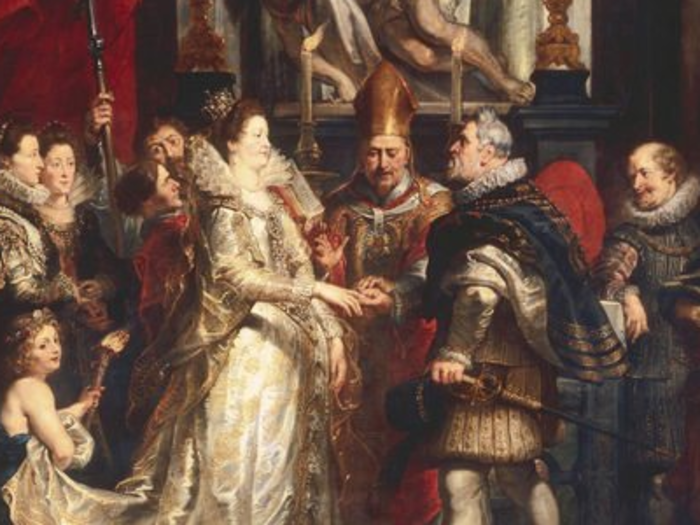
The bank was once one of the largest and most powerful financial institutions in Renaissance Europe, according to Business Insider's Áine Cain.
Over half of the bank's revenue originated from the Pope until 1434, and the bank's profitability allowed the famed Medici family to unofficially seize control of the Republic of Florence.
Yet the bank eventually overstretched its investments and its influence began to wane. Later corrupt episodes included defrauding a charitable fund devoted toward dowry payments.
Source: Business Insider

South Sea Company, which sold slaves and goods to Spanish colonies in the Americas, began in 1711 as a way to manage national debt. Many naive or first-time investors poured money into the company, leading to the "South Sea Bubble," author Helen Paul told Business Insider's Áine Cain.
Many company executives engaged in insider trading and bribery. The South Sea Company's dealings led to a wide-spread economic collapse that cost famed scientist Isaac Newton a fortune.
Source: Business Insider, Smithsonian

John D. Rockefeller founded Standard Oil in 1870, and the company eventually controlled 90% of the country's oil refining business. Rockefeller became America's first billionaire.
The Supreme Court eventually ruled that Standard Oil violated the Sherman Antitrust Act and split it into 34 companies. The decision led to an end of the American Gilded Age, with trust busting shifting power away from robber barons.
Source: The New York Times, HISTORY

George Tan Soon-gin, ex-chairman of the Carrian Group, took over the company in 1979 and built it into a billion-dollar empire in just 2 years.
Carrian Investments went bankrupt in 1983 after it couldn't repay its $1 billion in debt after a downtown in Hong Kong's property market.
In the aftermath of the bankruptcy, a Malaysian businessman murdered an auditor who was investigating Carrian's shoddy lending. During his trial, he accused Tan of ordering the killing.
A year later, Tan's lawyers successfully "outmaneuvered" government prosecutors to get him acquitted on fraud charges and free on bail, The Wall Street Journal reported.
When Carrian dissolved, it had debts of $1.3 billion — the greatest-ever bankruptcy in Hong Kong.

Pan Am, once an iconic American brand known for its iconic flight attendant uniforms and luxurious travel, shut down as a result of decreased travel during the weak economy, rising fuel costs after the Persian Gulf crisis, and a terrorist attack in Scotland two years earlier that killed 270 people.
The shutdown led to a loss of 7,500 jobs in the US. Once the airline that "led America into the jet age in the 1950s," its downfall resulted in the collapse of a symbol of American business, the Los Angeles Times observed.
Source: The New York Times, The Los Angeles Times

The mass market retailer in US and the UK devised the early concept for "dollar stores" that encouraged people to come in and browse even if they didn't need something.
Yet the chain expanded too quickly — opening a store every 17 days in the UK during the 1920s. The expansion led to its demise, as the company suffered from operating losses of $24 million in 1997. That year, Woolworths eventually closed its remaining 400 stores in the US after years of store closures, and its UK arm eventually became part of Kingfisher.
Source: MSN Money, The Guardian

Once the country's largest energy providers, Enron executives hid billions of dollars in company debt by manipulating financial models and lying to investors. Thousands of employees lost their jobs and retirement savings.
Enron's bankruptcy was the largest in US history at the time.
In 2006, a Houston-based jury convicted CEO Jeffrey Skilling for conspiracy, securities fraud, insider trading and lying to auditors. He had been sentenced to 24 years in prison, yet was released earlier this year after 13 years in jail.
Source: Business Insider

After its involvement in the subprime mortgage lending crisis, Lehman Brothers' top executives left and the then-fourth largest investment bank filed for bankruptcy. The fall remains the largest bankruptcy by asset value.
After the collapse, the Dow dropped 500 points in one day. For only the second time in history, a money market fund — considered safe haven investments — reports share value below $1. More than 2.6 million Americans lost their jobs by the end of the year.
While the Fed saved insurance giant AIG from bankruptcy and spent a total of $2.25 trillion on other bailouts, Lehman Brothers never recovered. Former CEO Dick Fuld, known as the "villain" of Wall Street, now gives investment advice to high-net-worth clients.
Source: Business Insider, The Guardian

The 178-year-old travel company announced bankruptcy on Monday after failing to secure £200 million, or about $249 million, in emergency funding to its lenders.
The bankruptcy led to global chaos for Thomas Cook passengers, a staggering 600,000 of which were left stranded. Employees found out they lost their jobs via social media, $40,000 wedding plans went up in flames, and one man reported being "held hostage" in a Tunisian resort until he paid Thomas Cook's debt to the hotel.
Source: Business Insider
 I spent $2,000 for 7 nights in a 179-square-foot room on one of the world's largest cruise ships. Take a look inside my cabin.
I spent $2,000 for 7 nights in a 179-square-foot room on one of the world's largest cruise ships. Take a look inside my cabin. One of the world's only 5-star airlines seems to be considering asking business-class passengers to bring their own cutlery
One of the world's only 5-star airlines seems to be considering asking business-class passengers to bring their own cutlery Vodafone Idea FPO allotment – How to check allotment, GMP and more
Vodafone Idea FPO allotment – How to check allotment, GMP and more India leads in GenAI adoption, investment trends likely to rise in coming years: Report
India leads in GenAI adoption, investment trends likely to rise in coming years: Report
 Reliance Jio emerges as World's largest mobile operator in data traffic, surpassing China mobile
Reliance Jio emerges as World's largest mobile operator in data traffic, surpassing China mobile
 Satellite monitoring shows large expansion in 27% identified glacial lakes in Himalayas: ISRO
Satellite monitoring shows large expansion in 27% identified glacial lakes in Himalayas: ISRO

Copyright © 2024. Times Internet Limited. All rights reserved.For reprint rights. Times Syndication Service.